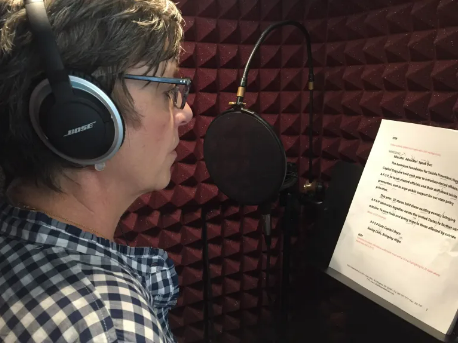Learning Objectives
- Vocal Delivery Tips {audio & video examples}
- Script Marking for vocal inflection
- Warm Up Exercises before voice work


Most of us don’t like the sound of our own voices.
Our recorded voices sound more high-pitched than we think they should, yet others don’t make that same observation about us.
When we speak we hear our own voices through sound waves in the air and transmitted internally directly through our skull bones, making vocal tone sound richer and in lower frequencies than when we hear our own voice when talking.

The good news is that you can train your voice to be more resonant through abdominal diaphragmatic breathing which helps the lungs fill more efficiently. This is “belly breathing” and involves pulling the diaphragm down with each inward breath. When you learn to control your air supply it gives you more control in using your voice without strain and sounding confident. It also helps to stand when doing voice work, because it doesn’t compress your abdomen and allows for deeper breathing.
But even more important than voice tone is vocal delivery style so this chapter will show you relaxation techniques, vocal exercises, and script marking techniques to improve conversational delivery.
Don’t stress about your voice quality and think you need to have the golden-sounding pipes that many broadcasters do. Instead, it’s more significant how you use your voice to sound credible and conversational. This is done by taking care of your voice and concentrating on speech clarity, pacing, and inflection.
Do warm-up exercises to pump blood into tissues to stretch and relax the muscles by getting them to work more efficiently. Vocal warmups help prevent injury to your delicate vocal cords. But they also help you sound better and, most important, they help you get in the right state of mind before your podcast interview, making a speech, or a presentation.
While warm-ups are simple, don’t be fooled into thinking they’re so simple they can’t be doing any good – over time, warm-ups will help your vocal agility and with confidence.

1) Warm-up our lips by opening the mouth vertically and saying “bah” “bah” “bah.”
2) Now switch to lips air-buzzing with Brrrrrrr ….. Brrrrrr …… Brrrrrr …..
3) Open up your mouth vertically and say an exaggerated “Lah, Lah, Lah, Lah”and sing up in pitch and/or down in pitch.
4) Trill your tongue by rolling with an Rrrrrrrrr.
5) Now say or sing the phrase Mah-May-Me-Mo-Moo.
6) Do a pitch change by counting to three and going up in pitch with each number; one-two-three; then go down in pitch and say three-two-one.
7) End with a familiar nursery rhyme tongue twister:
Peter Piper picked a peck of pickled peppers.
Did Peter Piper pick a peck of pickled peppers?
If Peter Piper picked a peck of pickled peppers,
Where’s the peck of pickled peppers Peter Piper picked?
WATCH the video & then follow along as you do 5-minute vocal warmups.
Warmups:
Vocal Exercises:
Tongue Teasers:
In a fun, interactive video NPR announcer Jessica Hansen offers three tips for training your voice.
After writing a script but before recording, it’s a good idea to practice reading it out loud so you can decide where to put in pauses for breathing and vocal inflection for emphasis.
You can indicate pause by using several dots (…) or a slash mark (/). Vocal emphasis can be indicated by underlining keywords or using ALL CAPS. Pitch levels can be identified by using an up-or-down arrow. Generally, an effective vocal pitch goes up when asking a question and down when making a statement.
For more information on script marking and polishing on-air delivery see the Broadcast Voice Handbook by Dr. Ann Utterback.

Fear of public speaking is one of society’s most common fears and to calm those nerves you need to be confident and calm. Be well-rested and loosen up with vocal warmups.
Mentally prepare for voice work by doing a countdown-to-calm down to say, “Five, four, three” — then silently count down to zero. When you are at zero you should be at your natural pitch level. This exercise helps you avoid starting out at too high a pitch level because of anxiety.

Changing vocal inflection is something we all do quite naturally when talking with friends to convey our excitement or disappointment; we’re not monotone or flat. Yet sometimes when facing a microphone or camera, that natural inflection gets buried underneath artificial stiffness.
The tone of your voice should reflect your passion, which will generate enthusiasm in your audience. Let your voice express joy, excitement, sadness, or sorrow to show that you care.
However, take care not to pass judgment in your tone if you doing a journalism-based podcast that should have a more neutral tone. You only want to express universal emotions such as sadness at the loss of life or joy at winning the lottery.
It also helps if you are writing a script, to speak out loud as you write to help create a more natural-sounding conversational flow.

When speaking through a microphone, slow down a bit from your normal speaking pattern so your words don’t jumble together. When someone can’t see you speaking, the pace of delivery affects their comprehension.
Many articulation problems come from speaking too quickly or from dropping syllables, leading to confusion over what’s being said.

If your pitch goes up at the end of every sentence, it’s called “valley-girl speak” or “uptalking.”
The other irritating speech pattern to avoid is “vocal fry,” a low growl sound at the end of a sentence. Some people blame the phenomenon on Kim Kardashian and those who want to imitate her. CBS News Sunday Morning contributor Faith Salie explains the phenomenon with a fun tongue-in-cheek look at creaky young women.

Try to be your authentic self rather than a carbon copy of someone else. You want to be conversational and avoid stilted language to establish rapport with your guest and audience.
But remember that you are hosting a show for others so you need to be energetic and to have excitement in your voice rather than sounding flat.
Beyond that, keep a consistent speaking level rather than being up-and-down with volume levels that are too loud or too soft.

When speaking into a microphone, there’s sometimes a strong breath of air that seems to explode into the microphone.
These plosives are worse on words with p’s and b’s. To avoid, position the mic at an angle instead of directly in front of the mouth, back away a little bit from the mic and use a pop filter or windscreen over the mic.

While the pop filter is a big help in reducing plosives, you can also angle the microphone to the side of your mouth rather than speaking directly into it.

The podcast hosting company Buzzsprout has additional advice for podcaster microphone techniques.
Many people develop an unconscious pattern of letting their voice trail off at the end of a sentence, almost like they have run out of energy. Maybe they have if they speak in one run-on sentence! Instead, try to have a clear focus to avoid lengthy monologues.


